We Have to Talk About Jotaro Kujo

Let's get one thing clear right away:
Jotaro Kujo is not the best JoJo, but he is the best character in JoJo's Bizarre Adventure, the long-running manga by Hirohiko Araki. Hands down. No contest. End of story. Jotaro is the most subtly expressive and understatedly tragic character in the series. He conveys his full range of depth through the visual languages of character design and cartooning. The construction of his core shapes, the weight and quality of the lines that make him up, tell the story of a stoic man struggling to remain in control of the overwhelming emotions that course through him in a world that escapes his power to manage.
Okay, some rivals to his crown appear in the seventh part, Steel Ball Run, in the form of Johnny Joestar and Gyro Zeppeli. But that's a different timeline that Jotaro isn't featured in and this is my newsletter. I make the rules.
So, why am I arguing that Jotaro Kujo is a good character? He's the face of the JoJo's franchise. Acting as the brand mascot, Jotaro has been beloved, if not revered, by series fans since his appearance in 1989. He is the overpowered Stand user and protagonist of third chapter Stardust Crusaders, proving to be nigh invulnerable after his magical soul-powered ghost best friend Star Platinum manifests the ability to stop time at will. Everyone knows Jotaro is cool as hell.

But that's the thing.
I don't think Jotaro is cool. I think he's poignant, beautiful, and tragic. I also think he's a cheesy dork who should be treated as such, but we'll get into that later. The point is, I find the overall marketing and public perception of the character to be an inaccurate representation of Jotaro and the themes of his story, especially as he's aged over the course of the manga and anime series. I think it's very easy to take some isolated panels or scenes and create an image of this cool, calm, soft-spoken badass who beats the shit out of you first and asks questions later. It certainly sells collectible statues and action figures.
(To me, specifically. It sells them to me.)
But that isn't the totality of Jotaro's arc within the series, nor is it a fair assessment of just how much he grows, changes, and, sadly, comes to disappoint his audience. This is a tragedy, after all.
The point of this essay will be to make the case for why that is. For why I love Jotaro Kujo as much as I do, and for all the depth of feeling I find within his story. Being that it's May and this goes out the day before my birthday, let's call this my little gift to myself.
So let's talk about why Jotaro Kujo is the best character that nobody understands but me.
(Okay, I'm kidding.)
(But only a little.)
So, what is JoJo's Bizarre Adventure? Well, the good news is I wrote a whole thing about the series and my feelings on it. You can read it if you haven't already. But if you just want the short of it:
A great deal of ink has been spilt over JoJo's Bizarre Adventure over the thirty-five years since Phantom Blood. You're most likely to hear about the very obvious and oft-discussed references to musical artists, songs, or albums. You'll definitely hear about Araki's love of fashion and how he incorporates fashion and modeling into the iconic poses his characters strike. Someone will eventually tell you about the influence of Italian art, sculpture, and architecture on Araki's work, and how he claims to have found his style while traveling in Italy. It's impossible to talk about Giorno Giovanna or Gyro Zeppeli without it.
Somewhat less likely as an outsider to the franchise, you might hear about JoJo's themes. It is a battle manga, wherein highly skilled, supernaturally endowed fighters engage in increasingly elaborate, frequently reality-bending fights. From the use of the magical martial arts skills of Hamon in Parts 1 and 2 to the soul-powered avatars known as Stands in Part 3 and beyond, JoJo's is about fighting in every connotation a fight can take. Each act hinges on the latest JoJo cultivating a ragtag group of companions with whom he or she battles the physical, psychological, and existential threat posed to that generation.
…
Yet, in each part, humanity prevailed. The bonds between those who stand against evil and strive to do right even as they are slapped down by the forces of fate itself are far stronger than the power of those who seek to destroy. Love, conviction, and resolve triumph in the end, no matter how greatly the heroes suffer on their path or how much they lose. At its core, and as stated by Araki himself, JoJo's is a text that sets out to reaffirm the essential goodness of the human soul and the boundless potential of its spirit.
Also, there’s an immortal vampire lord named Dio who is locked in a multigenerational battle with the Joestar family through a century of strife. Just bear that in mind.

Jotaro's first appearance in the opening pages of Stardust Crusaders is marked by a kind of sharp, chaotic dissonance. His mother Holly recounts his idyllic upbringing set against images of big, comfortable homes, where she raised her sweet little boy into a smiling teenager who loves her cooking. This tender image of a loving child is broken by the reveal of Holly bailing her now seventeen-year-old son out of jail.
At this point in the series, Araki was still figuring out Jotaro's characterization. Jotaro is the grandson of our last JoJo, Joseph Joestar, and carries over a lot of his more bombastic nature. Joseph was a stark departure from series progenitor, his gentlemanly grandfather Jonathan Joestar, with his fast-talking, hot-tempered antics. Being that he's half-Japanese and was raised in Japan to trade in more of its cultural signifiers, Jotaro is already a big step away from the manga's narrative roots in Britain and America.

First and foremost, Jotaro's a delinquent. Perhaps more in presentation than action, but he styles himself as a delinquent nonetheless. He's big, surly, and locked behind bars. He even cusses at Holly, whose smiling acceptance reads first as troubling until we realize that she simply doesn't buy into his bad boy persona. A boy insulting his mother feels like it should be a bigger deal but Holly doesn't take it seriously. Nobody really takes Jotaro seriously, it seems, as the skittish police officers escorting Holly remark that he's free to go but won't leave his cell.

While it's never stated as the reason for his rebellious phase, Jotaro's father, Sadao, is out of the picture. Sadao is a jazz musician on tour during the series and makes no appearance. Given that Holly's memories of her son don't include Sadao, we can easily infer that her husband was largely, if not completely, absent from their lives. Jotaro makes no mention of his father, either, and appears to have no real connection or relationship with him. It's sad to think of a boy acting out to get the attention of a father who's chosen his career over his family, but it's the picture we're left with in these opening pages.
Araki's ornate, heavily detailed style at this point in time gives us a Jotaro made of big, complex shapes. His bulk takes on rounded edges punctuated by daggers of hair jutting from the back of his visored cap, the sleeves of his school uniform coat ruched up, uniform pants riding up high at the ankles. He wears a heavily modified traditional gakuran or tsume-eri with loafers sans socks and a ripped cap.
Ornamentation drips off of him in the pins punched into his cap, chains attached to his coat, giant bracelet, and the overall sloppiness of his loose belts and untucked undershirt. The vest under his coat seems to pucker at its buttons as it sits low on his collarbones, exposing the top of his muscular chest to show skin.
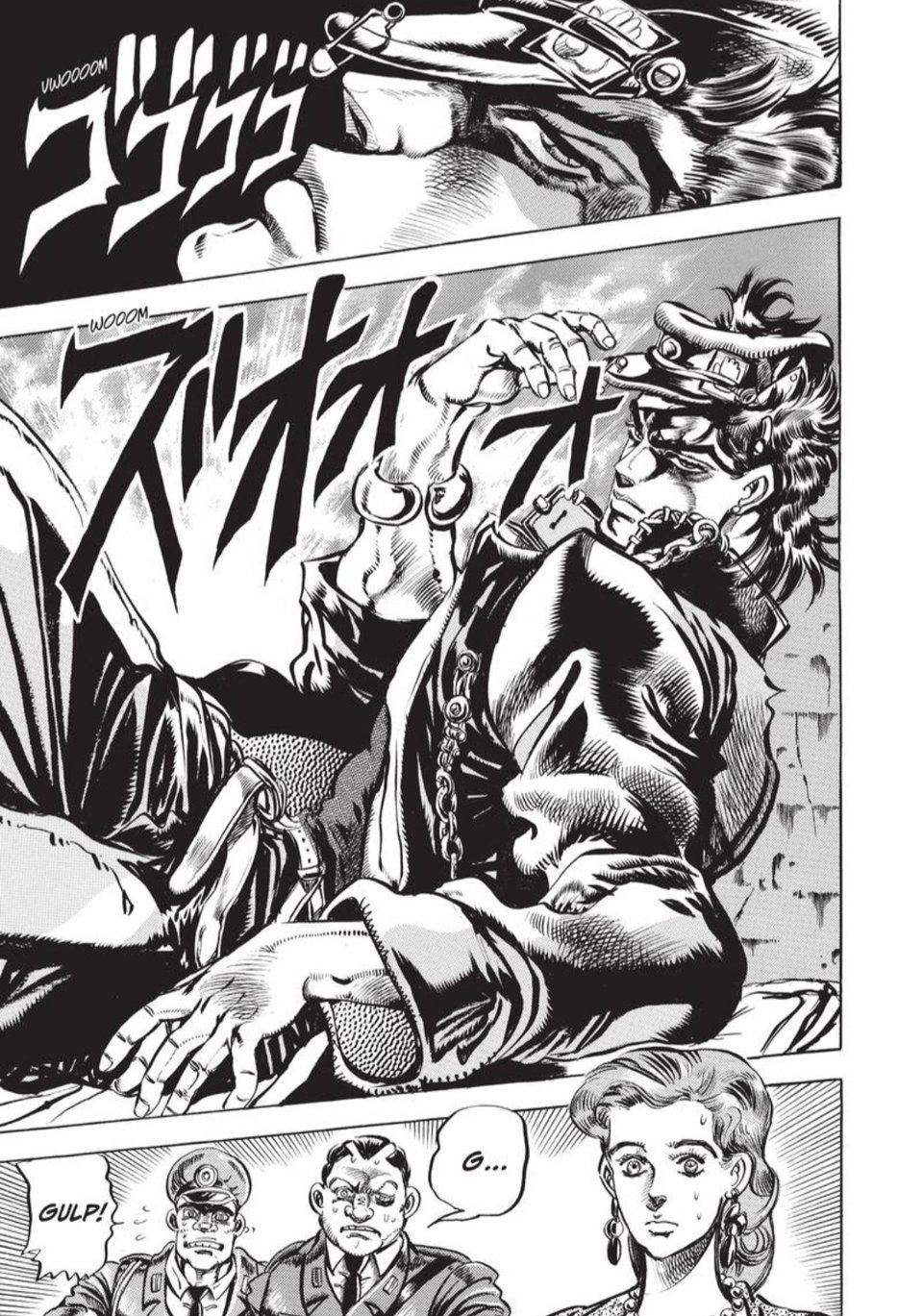
The story is this: Jotaro Kujo is the descendent of Jonathan Joestar and Dio Brando is back. The vampire lord has returned from his grave at the bottom of the sea and is seeking to amass an army of Stand users, people who manifest guardian spirits to do battle. In taking Jonathan's body through a truly goofy process, Dio has gained the power of Jonathan's latent Stand, The World. This has also activated the Stands in the rest of the Joestar lineage, including Jotaro's Star Platinum, which appears during a fight with some other delinquents.
Mistaking his soul-powered guardian for an evil spirit, Jotaro refuses to leave his jail cell to protect everyone, specifically his mother, from it. It’s only when Joseph arrives from America bearing the news of Dio's return that Jotaro begins to understand his newfound power. But the body isn't always prepared to assume the power of its Stand, which can cause sickness and eventual death. And so Holly falls ill and Jotaro joins Joseph and a group of other stand users -- Mohammad Avdol, Noriaki Kakyoin, and eventually Jean Pierre Polnareff and Iggy the dog -- stop Dio and lift Holly's curse.
Now, knowing that all of that was word salad, I want to talk about Jotaro's design. He is a jumble of visual contrasts from the outset. Jagged hatching creates the heavy folds of fabric that appear at once too tight and too loose for his hefty frame. He is immediately recognizable as a teenager in his school uniform, but its many modifications externalize his rebellious attitude. Textured materials contrast smooth metal bits and bobbles jangling from him. Sharp angles intersect with thick, round musculature such that he appears both pleasant and threatening in totality. Curved lines frame the exposure of skin, such as the wrists, ankles, chest, and face, which is a strange juxtaposition for someone who presents himself with such bravado.
Araki positions his delinquent in vulnerable poses, bare wrists against bare ankles as Jotaro holds tightly to himself. Every tough guy stance taken in these early chapters is undercut by the insistence of showing these delicate wrist and ankle bones, all his gruffness tapering into the points of long feet in shoes sans socks. There is a boyishness to it, a careless vulnerability that everyone else, especially Holly, notices.

As Araki settles into his evolving style and characterization for Jotaro, the character fully becomes his own person. His lines become cleaner and more efficient as his outfit loses its most ostentatious elements. His school jacket lengthens into the drape of a full trench coat, making him appear taller, slimmer, and more composed. Such a busy aesthetic is hard to maintain in a weekly manga, which is for the best in the long run. His temperament softens into the quiet, cool, but just a little mischievous JoJo who joins Joseph on their globe-trotting adventure. The juvenile zeal for brawls that landed him in jail in the first place focuses on protecting his friends and family from bad guys as his Stand emerges as a distinctively protective force rather than a destructive one. His mother and the enemy-turned-ally Kakyoin remark on how caring Jotaro is beneath the surface, which continues to reinforce that gentler nature even as he looks less the part.

Yes, Jotaro is still a bit of a smart-mouthed punk in the first few arcs, but, like. It's fine. Nobody believes in the act and after getting his ass handed to him a few times, he chills out drastically. Modeled after characters portrayed by Clint Eastwood in films like Dirty Harry and A Fistful of Dollars, he becomes quite stoic, rarely exerting himself or expressing strong emotions. He strolls around with his hands in his pockets, only speaking when he feels it's necessary.
Despite this self-imposed silence, he still shares corny jokes with Kakyoin and makes dry remarks. He does the occasional silly and out-of-character stunt to impress his friends, and repeatedly puts his body (and sometimes his dignity) on the line to save the ones he loves. Characters like Polnareff and Kakyoin push to the front of the pack (Polnareff more than others, to be fair) as Jotaro eases into the background as part of the ensemble. He is frequently observed by other characters, his thoughts and feelings related to the reader through dialogue or the gestures of linework rather than internal narration. You observe Jotaro as he observes those around him. His newfound silence allows him to show his care through action, like a wry smile when someone makes a joke or a hand on someone's shoulder when they need it most. Besides his hat, his most striking feature is the heavy, jangling chain attached to his jacket collar, a visual signal of his strength and power. He is still a brick house with a Stand to match, and he won't let you forget it.
All of this, with those vulnerable parts still showing. His wrists and ankles, collarbones, throat, and eyes. Things that would be easy to attack. That would subdue him if taken out. The less imposing Jotaro becomes, the more of Holly's sweet boy he is revealed to still be under his exterior, even as his power grows and his resolve hardens with each battle.
I find that subtle softness so compelling when wrapped within the cool one-liners and the battle manga posturing. By the time Jotaro battles Dio in the skies of Cairo to save his mother, his personality is as streamlined as his appearance. He is quiet, determined, and always thinking five moves ahead of his opponents. Jotaro is too smart and powerful to lose. But it isn't enough. Joseph, Avdol, Iggy, and Kakyoin have all died at this point, leaving only a devastated Polnareff and a vengeful Jotaro to take down Dio. I know there is a vulnerable boy within this hardened warrior, and that makes this final battle so gripping.

There is also a wildness in his eyes that feels like it draws on that chaotic look Araki gave him way back in the first few chapters. A lust for violence that his cool, well-composed exterior, made of sharp points and hard black shapes, can't adequately contain. He has now fully assumed the role of Dio's judge, jury, and executioner, making good on his earlier iteration's waxing about justice. Even so, his violence, whether enacted by Star Platinum or his own hand, is still defensive -- a protective instinct to help and do right by others -- rather than offensive one.
Despite Jotaro's calm exterior and explosive power, Araki has managed to fill each pencil stroke with such subtle duality. Even as Jotaro defeats Dio, saves Holly, and resurrects Joseph (through another truly goofy process), he has lost so much to this fight. That sweet-hearted boy Holly recalled in the opening pages is still there, but he's been broken in a way we won't come to fully understand until much later.

The opening pages of Diamond is Unbreakable are a little disorienting. Jotaro Kujo appears in the city of Morioh looking for Josuke Higashikata, a high school student and Joseph’s illegitimate son from a brief affair. He is introduced by Koichi Hirose, an unassuming student with an affinity for investigating the town's history and eccentricities. They quite literally collide on the street when the very small Koichi bumps into the slab of meat that makes up Jotaro, sending the teen’s book bag and all its contents flying. Star Platinum emerges in a flurry of hands to pick up Koichi's belongings and pack them back up as if nothing happened. When Koichi looks up, we are met with a twenty-eight-year-old Jotaro.
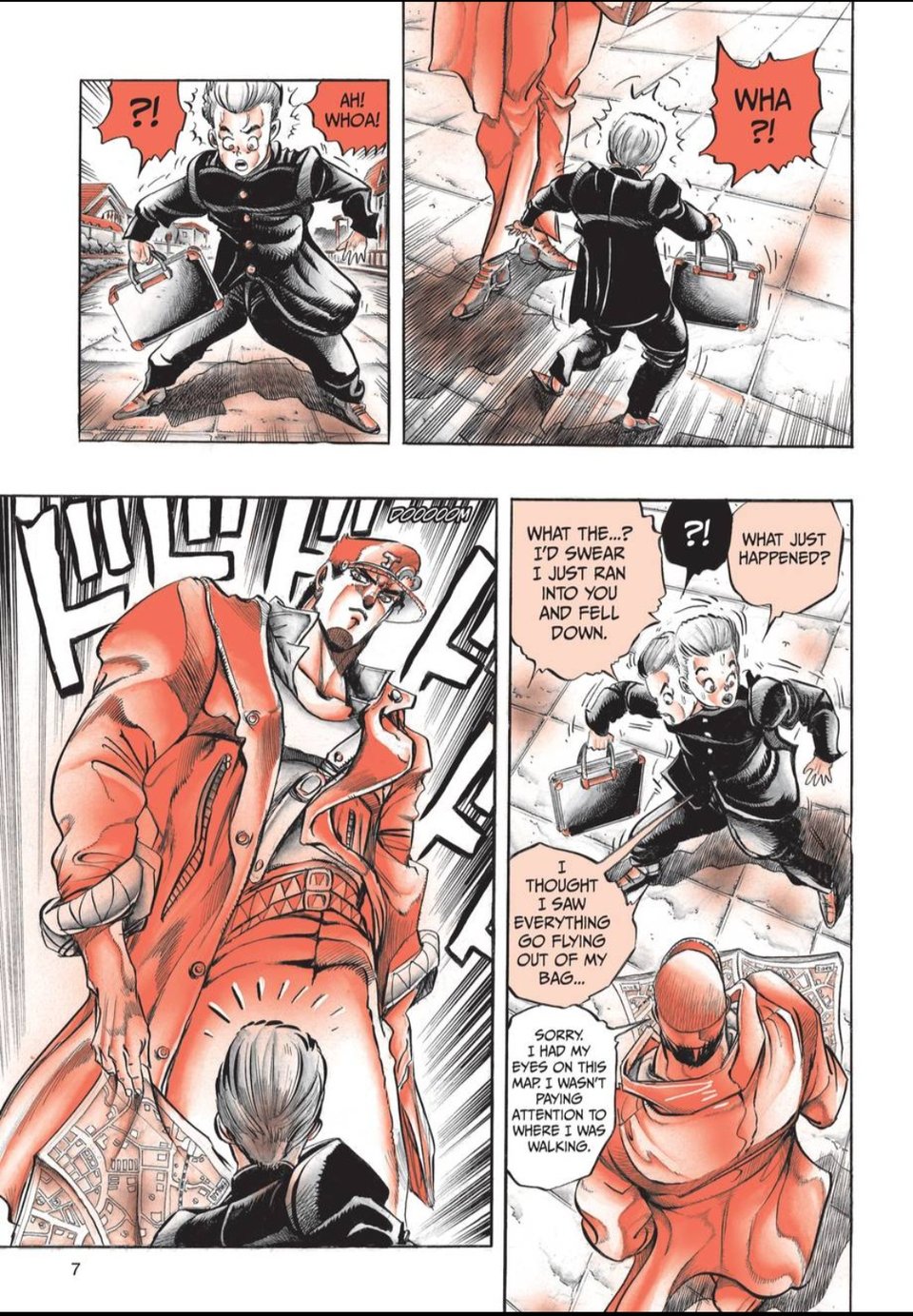
Here, Jotaro is introduced in a cozy neighborhood on a sunny morning. He wears a white outfit that at first recalls the black student uniform we last saw him in, but it's the details that make the difference. His sleeves are rumpled and lazily shoved up to his elbows, his long jacket draped over him in heavy folds. There are zippers and buttons, zigzagging belts and protrusions everywhere. The collar of his button-up is undone and splayed out across his chest under his form-fitting sweater, the collar jutting out in dramatic points. Of course, his cap is back and adorned in chunky buttons and ornaments, but he's missing his massive chain.
The messy bulk of his outfit looks careless. Sloppy. Yet this is the most reserved Jotaro we’ve ever seen. As Koichi remarks, he looks big and scary, but is quiet, polite, and has the air of an intellectual about him. In the years since his days battling Stand users, Jotaro has taken his ass back to school, graduated college, and become a respected academic in the field of oceanography. His clothing calls back to his delinquent teens in a way that feels familiar, but he is strikingly different from who he was over a decade ago.
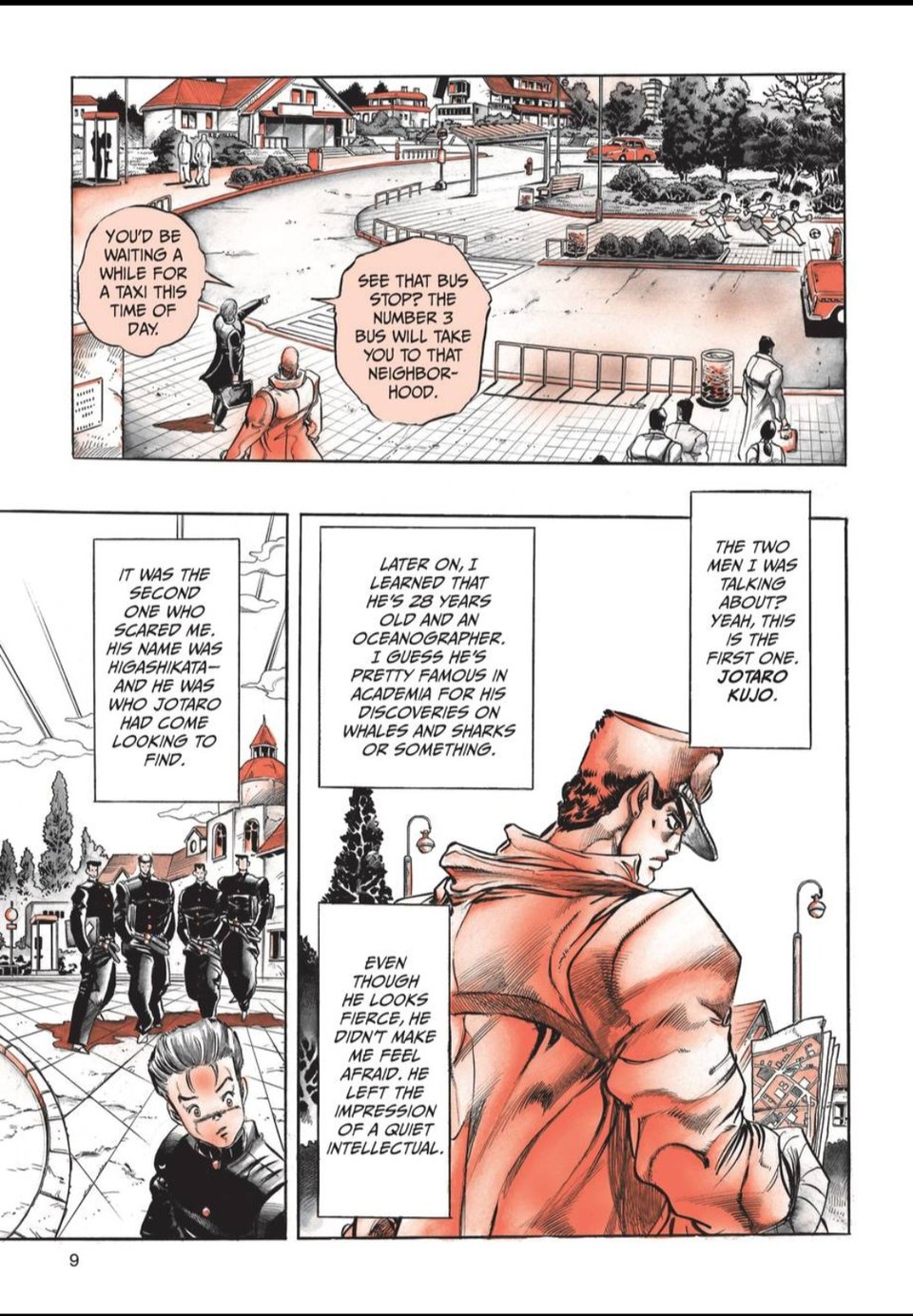
I think what is most interesting about Jotaro's appearance in these early chapters of Diamond Is Unbreakable is how it conveys a sense of thematic and narrative cohesion through visuals alone. As Josuke makes his appearance as a kind-hearted goof, sweet and a bit silly, he inherits Jotaro's Stardust aesthetic while still making it his own. The lumpy, unflattering shapes of the black school uniform open in the sharp lines of Josuke’s collar to create a heart with his exposed shirt underneath. Badges, buttons, and zippers break up the fields of black fabric with the playfulness of hearts, anchors, and the letter J. Whereas Jotaro has hair cresting from the back of his cap, Josuke's hair is styled in a big pompadour with thick crisscrossing lines evocative of a hamburger steak.
It's only when Josuke is hassled by a bunch of much harder boys that his Stand, Crazy Diamond, emerges. We come to learn that Josuke's gentler nature is quickly overridden by two things: love for a good scam and rage over people making fun of his hair. Now Jotaro has to deal with a hot-headed teenager, putting him in the position of his own mother during his introduction. Like Jotaro before him, Josuke's a delinquent mostly in reputation only, in a modified gakuran that conveys his ultimately futile struggle against authority. Josuke comes from a comfortable middle class (or better) family, raised by a feisty young single mother and kindly cop grandfather. And like Jotaro, his Stand is a protective extension of himself rather than a purely offensive one, possessing the ability to heal everyone but Josuke. Self-sacrifice is a defining Joestar trait, after all.
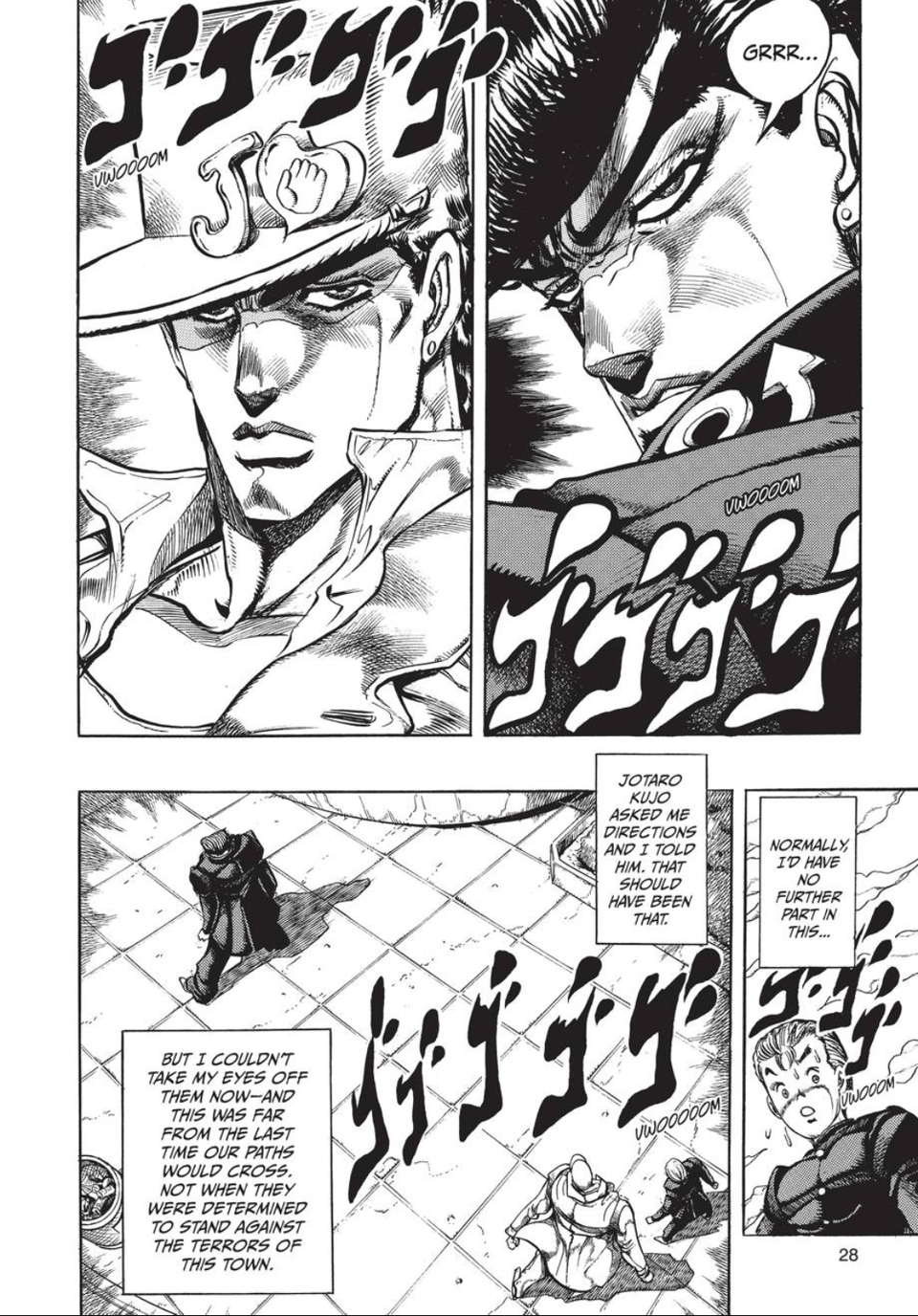
It's in this visual and thematic passing of the torch that I find Jotaro's appearance so compelling in Diamond Is Unbreakable. He trades the brooding of black for the composure of white while Josuke assumes his own version of delinquent costuming. His look changes over the events of the series along with Araki's style, becoming softer, slimmer, and prettier with the rest of the cast. The white trench coat, wide-legged trousers, cap, and leather shoes remain consistent throughout, while his final style includes a black turtleneck sweater and open patterned waistcoat. It follows 90s men's streetwear trends, with the prevalence of baggy pants and turtleneck sweaters, snapbacks and heavy layers. His shoes, funnily enough, remain long, pointed, and small. Their points draw the lines of his coat and arms down to meet at the tips proportionately tiny shoes.
As if balancing on these tiny points, Jotaro is visually at his most reserved, no longer showing vulnerability through exposed skin and delicate posing. The black turtleneck that is his most enduring look of this era rides high to cover his throat, locked under his jaw and adorned with the same palm badge from his hat in Stardust Crusaders. He fully looks like a man trying, and generally succeeding, to maintain his composure. It seems he no longer needs that dangling chain to project strength, confident enough in his ability and resolve as a fully formed adult. Similarly, he has chosen not to continue to train and hone Star Platinum in the intervening years, allowing his Stand’s time-stopping powers to wane.

As he investigates the sudden appearance of Stand users in Morioh, Jotaro is determined to keep someone like Dio from amassing another army. The task wears on him in private moments, evoking more emotion than we tend to see from him. That appears to contrast his more composed appearance and less powerful Stand, but I think this dichotomy works together to create a more nuanced portrayal of Jotaro. He doesn't value outward demonstrations of power the way he did in his youth. In allowing his explosive abilities to settle down a bit, I think it shows a growing respect for that power. Star Platinum is fully integrated into his being as an extension of himself, and coming to understand through Dio that sheer force is not enough to protect the ones he loves, I think he comes to better understand those protective, defensive instincts he's always displayed.
With Josuke and his cast of friends and frenemies assuming their roles as the leads in this bizarre adventure, Jotaro serves as a guiding presence. He acts as a cool older brother figure to Josuke and a mentor of sorts to Koichi as this generation tries (very cutely) to impress him. Yet Jotaro is quieter than we've seen him in the past. If not quieter, than taking on a different kind of silence. He stoically appears to deliver exposition to the Morioh gang when needed, sure, but he's often standing at the edge of a panel like a long white specter. Jotaro's dialogue is frequently stilted by ellipses as he processes his responses, standing rigidly with a stern look obscured by the shadows cast by his hat. He's harder to read than he's ever been given the greater distance from the reader, something that annoys Koichi during an arc spent together looking for the serial killer Yoshikage Kira.

(Did I mention that Diamond Is Unbreakable is a Twin Peaks-like slice of life action comedy in a small city that's plagued by Stand users and supernatural serial killers? Well, there you go.)
None of this is to say that Jotaro is cold or detached, per se? He simply struggles to convey his feelings in a way that feels different than in Stardust Crusaders. As a young man, Jotaro spoke when he felt like it and conveyed his feelings through action and expression. He was mysterious to someone who didn't know him but was easy to read by his family and friends. Now he is visually and emotionally removed from scenes, a stark white stripe of a man marked by his obscured gaze and resigned silence.

Mentions of Dio, thoughts of Dio, send him into sharp spikes of panic or quiet simmering rages. In this way, Jotaro is the ghost of his past self, the one left behind in Cairo that night that his friends died. I feel like the anime adaptation by David Production does a really great job of making that subtext fully text in the show, but it's there in the manga, too. Jotaro remains in mourning, a man in white rather than black, in a way that the Morioh kids don't understand and won't have to. Their losses are far fewer, painful still, but the win feels worth the struggle. Yoshikage Kira doesn't get to live rent-free in the minds of Josuke and his friends the way Dio Brando does in Jotaro's. The more mature Jotaro is, the less control he truly has over his emotions, often unable to marshal the words to say what he wants to say. Such that, when he does, with a hand on Josuke's shoulder or a smile for Koichi, it matters so much.
It's…a small victory.
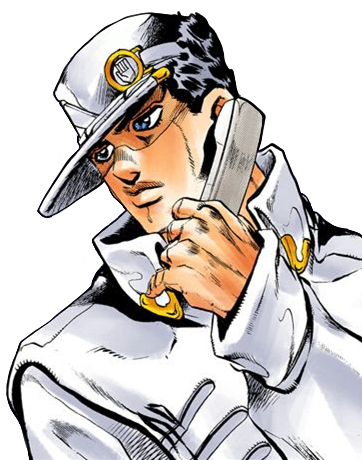
When we next see Jotaro in Vento Aureo, he is at his most refined yet. He is also at his most distant from the reader, seen first in Koichi's flashback as the protégé arrives in Italy at Jotaro's behest. Later, he appears in a telephone conversation with Koichi, far removed from the events of the story. Vento Aureo stars Giorno Giovanna, a teenager who dreams of ascending the ranks of the mafia to become the Gang Star, the greatest criminal in Italy. He is also Dio's son, fathered during the vampire's time in Cairo parading around with Jonathan's body, making Giorno both a Brando and a Joestar.
(Yes, I know. Anyway.)

Koichi is sent by a pained Jotaro to get a sample of Giorno's DNA for testing. Here, Jotaro is presented at the height of his career, framed in a beautiful home with a beautiful office. The white coat and trousers are redesigned with the cleaner lines and crisp formality of a naval officer's uniform. His hat and collar are stiff and adorned with emblems. Buttoned up at his collarbone over a turtleneck, his coat opens in a drape of big buttons and angled stripes along his ribcage. This decoration too makes me think of the stars and bars of a military uniform, flourishes breaking up the tight white silhouette.
Here, in his office with a photo from his time with his long-gone friends, Jotaro is…vulnerable? Apologetic? He expresses genuine regret to Koichi for sending him into this mess when his protégé has a weird and bad run-in with Giorno. While he is only seen in flashback and on the phone, Jotaro is unable to contain his grief the way he has in the past. He lives beside it in a way we've never really seen before.

Looking at the framed photo on his desk of Joseph, Polnareff, Kakyoin, Avdol, and Iggy, Jotaro lives on as the last Crusader. Three of his friends died in Cairo. Polnareff has vanished at this point after being a close friend and ally. Joseph is an elderly man, growing more frail and senile with time. Jotaro has no chains or one-liners to hide behind, no displays of strength to offer. He's a man now into his thirties who is beset by trauma and grief, looking for an answer to the obvious question.
What does Jotaro intend to do to Dio's son, his own distant relative, if he finds him?
Realizing that going after Giorno would solve nothing, help no one, Jotaro quietly exits the story.

The sixth part, Stone Ocean, is kind of a mess, even by JoJo's standards. I don't think that's a particularly hot take. For its many bumps and bruises, it's also a beautiful and gut-punching piece of storytelling. It stars the last canonical JoJo of the primary timeline, Jolyne Cujoh. She is a naive, rebellious, and somewhat silly Y2K girly who takes the fall for her boyfriend's hit-and-run accident and ends up with a prison sentence. Jolyne is also the estranged daughter of Jotaro Kujo, who is absent from both her life and the narrative. It makes for a strange but fitting beginning, to see Jotaro's daughter in a cage like her father before her.
The set-up sees Jolyne ripped from her comfortable life with her mother in West Palm Beach and tossed into Green Dolphin Street Prison. There is danger everywhere, from the oppressive eye of the prison guards to the unpredictable Stand users who seem to encircle her. Even though Jolyne is a fair bit harder than some of her delinquent relatives, getting a tattoo and falling into a gang at a very young age, she is just a kid. She's smart and scrappy, sure, but she's also a goofy teenage girl who's in way over her head and wants her mother to comfort her.
There is no real material impetus for her destructive tendencies. Despite the streetwise front she puts up, she isn't stealing cars or getting into trouble out of necessity. She isn't Giorno, after all, stealing and scamming as a way of life. Instead, it seems Jolyne acts out to both defy and get attention from her absent father, who remained distant with his research for many years before he divorced her mother and vanished entirely. She wants him to save her, to fix the problems she's made for herself, but he never comes. It becomes a self-fulfilling prophecy, a cycle of self-sabotage that never yields the results she so desperately wants.
Reminds me of someone.

The only trace of Jotaro comes from a beetle locket that arrives at the prison with her belongings, a trinket left with her mother when her father quietly exited their lives. We see a photo of her parents within it, model perfect and dressed in white, and we feel…confused? Betrayed, perhaps? Jotaro is not this man, this dirtbag dad who Jolyne grits her teeth and cusses about. This isn't the man we know, who Josuke and Koichi looked up to as a mentor. But it is the man who left his family and, most importantly as we are operating from Jolyne’s perspective, abandoned his daughter.
Stone Ocean is painful to engage with. I think it's the most poignant chapter of the series, and perhaps the most devastating as a reader who feels so deeply for and about Jotaro. It's also kind of a slap in the face? But in a good and productive way? Araki has built upon the narrative part by part, molding the characters and the courses of their lives around the latest story he wants to tell. This means that Jotaro didn't have a daughter during Diamond Is Unbreakable or Vento Aureo, but he does now. We have no choice but to look back at those parts and project Jolyne into them, a child without her father. His actions are retroactively very fraught and pretty indefensible as a result of that new context. While he was running around doing cool shit, he had a wife and daughter back home.
And he ruined his relationship with his own child by remaining at a distance, the way his father potentially did to him.

As much as I love Jotaro, he is not allowed to be the perfect mascot and face of the franchise. He does not get to be frozen in time at the height of his power during Stardust Crusaders. Jotaro is traumatized. He hurts people. He hurts his family. He leaves his child for reasons neither she nor I understand in these early chapters. He is fully the ghost he threatened to become in Diamond Is Unbreakable, a white figure at the edge of the panel, silent, gaze thrown to the side to avoid eye contact.
This is made most clear when Jotaro finally appears. The beetle locket contained a needle, made from the stuff that activates Stands in those who possess this power in their bloodline. (Just take my word for it, it's fine.) Opening it pricks Jolyne’s finger and she steps into that power as her Stand, Stone Free, fully manifests. Jotaro sent this to her so she could defend herself. This is relevant as Jolyne realizes the scope of the conspiracy to get her into prison extends beyond a crappy boyfriend and indifferent justice system. The acolytes of Dio Brando have colluded to imprison her to use as bait to draw out Jotaro, the only one capable of stopping them from realizing the vampire lord’s ultimate plan.
(The plan is admittedly complicated and weird to explain, but trust me when I say it's not good. For, like, humanity.)
And when Jotaro finally comes to rescue his daughter, arriving triumphantly to redeem himself for whatever faults or stumbles he may have had, he is…something else. The slow reveal is set against the ominous slithering characters that signal danger, positioning Jotaro as a threat. Jolyne rushes into the prison's meeting room expecting her mother and finds her father instead. Before her, he has regressed into someone we only vaguely recognize.
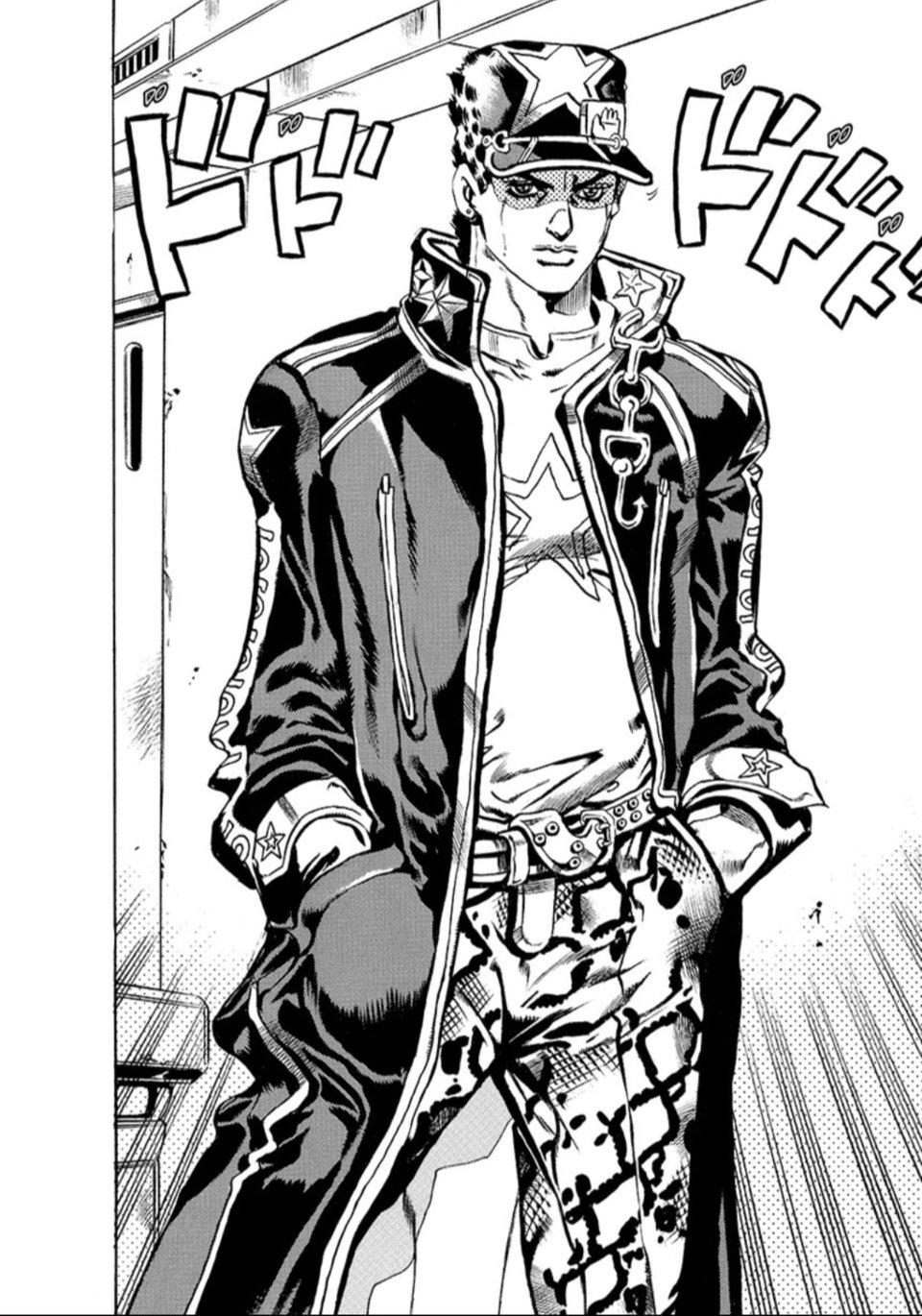
Jotaro is now forty and a respected college professor, earning a teaching degree amid his other professional and academic achievements. He stands with his hands in his pockets wearing a cap, a long coat with “JoJo” trailing on the sleeves, a long-sleeved white shirt adorned with a star, and snakeskin pants that melt into boots the way his hat melts into his hair. The lines of his coat are clean and orderly, with a high collar and big stars and embellishments like military insignia. The shirt dips in a miniscule V but doesn't reveal skin, appearing casual but still restrained. Even his hat appears as a more carefully constructed and embellished version of his youthful cap.
Everything is rumpled and wrinkled. The sleeves of his coat seem too long, his shirt too loose. His belt is pulled out and sloppily tucked into itself. A large ornamental chain dangles from his starched collar like a teenager again. The barbed hook at the end of the chain's length adds an element of danger to his look, a sharpness to his outward projection of strength and power. The evocations of military dress command an authority that he simply has not demonstrated. He's not a father or a respected academic. He looks like he's pretending to be a hardass and has nothing to show for himself.
Because he doesn't. Not when it comes to Jolyne.

Jotaro is a delinquent in his daughter’s eyes, dressed like a midlife crisis made flesh in materials and textures that feel weird for his temperament. His cold demeanor is even more perplexing as he carries on as if nothing happened between them, not understanding Jolyne’s rage and grief. Perplexing not because of the patronizing nature of the act (although it is infuriating!) but because it doesn't seem to occur to him that she should have a problem. She's a Joestar. She's strong. She can handle this because he believes in her. He loves and trusts her.
But she doesn't know this.
Because he hasn't told her.
Because Jotaro doesn't convey his feelings, so he doesn’t understand that people don't understand his feelings. He never has fully grasped this, an eccentricity rather than a mark of callousness. That quirk has never hurt more than it does now when faced with a daughter who doesn't understand him. He left his family to protect them from people like Dio and the devotees who serve the vampire after death. The bad guys wanted him, and so he put his loved ones in danger by being with them. His mental calculations yielded one devastating answer. The only thing he felt he could offer his daughter was the power to protect herself without realizing that what she wanted, what she needed, was a father who loved her.
Why would he not realize that? Why would he think that power is all he's good for? I don't know, but it hurts.

So here we have Jotaro, hands in his pockets, smaller and slimmer than he's ever been thanks to Araki's evolving art style. He appears aloof and self-contained. Their brief reunion turns quickly into a botched escape attempt when Jolyne and Jotaro battle their way out of the prison. Jotaro is gravely wounded with his Stand and memories stolen by Father Enrico Pucci, Dio's trusted partner in life and world-ending machinations. Just as quickly as he arrived, Jotaro is gone, falling into a catatonic state without Star Platinum, his soul, his spirit.
Before he collapses, he tells Jolyne that she’s important to him, in what feels like the most vulnerable and honest he's ever been. The moment is as cathartic as it is devastating. It also comes at the heels of many disorienting moments, seeing Jotaro struggle and fail to express himself. Seeing him devolve into a worse version of himself, draped in the trappings of authority to cover the deep grief and fear that have driven his life until this point. He is at his most isolated here. His most cut off. And it's conveyed to me through the appearance of a detail so innocuous as the chain piercing his coat’s tall collar.
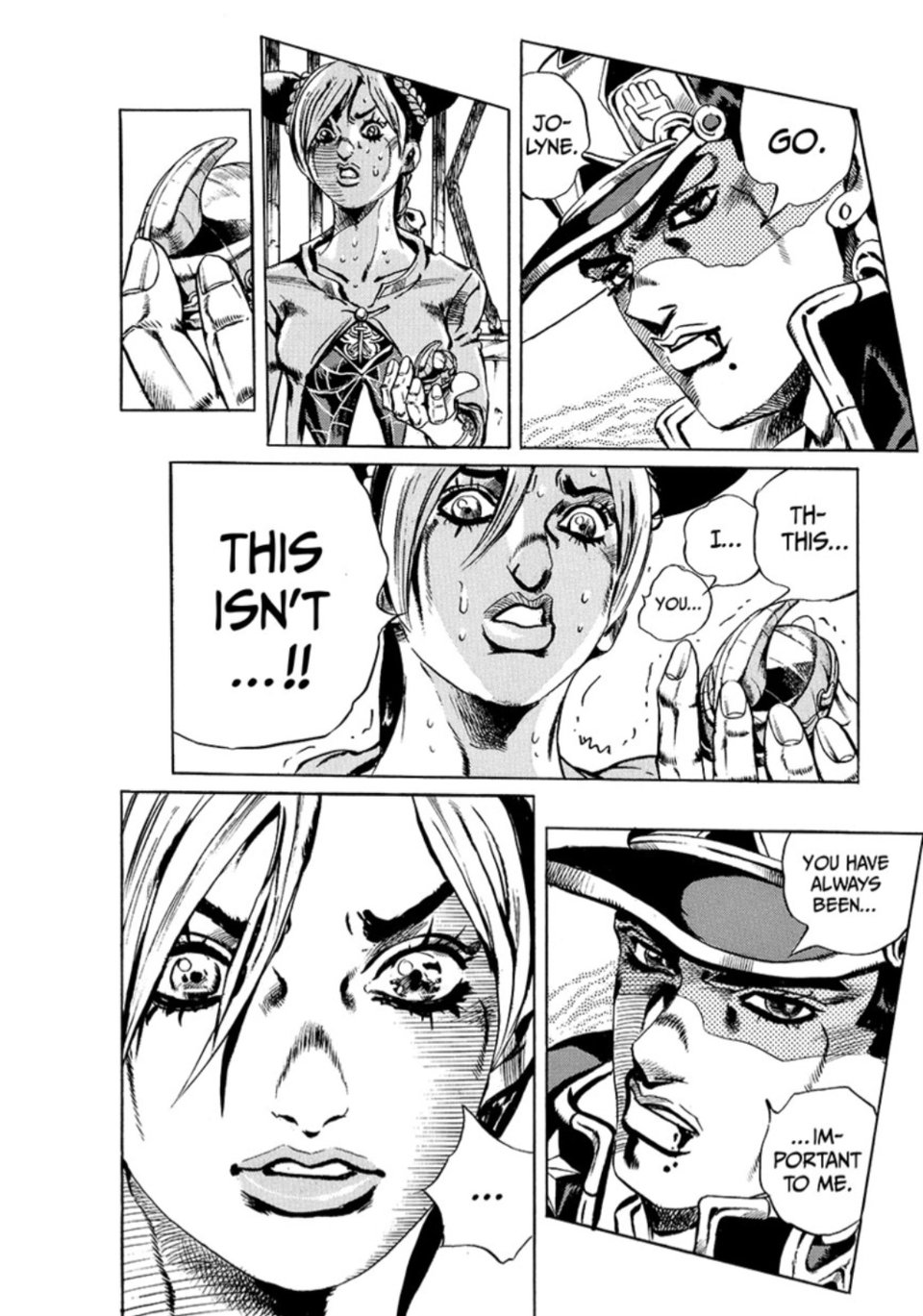
With her father again taken from her, by the force of his enemies rather than his own misguided choices, Jolyne is left only with her resolve to guide her. Getting Jotaro to safety, she commits herself to retrieving her father's memory and powers. She returns to the prison to face his -- their -- enemies and comes to understand why he made the choices that he did. Not absolve him, not really, because I don’t think forgiveness is the point here, but to see his perspective as a boy in Cairo who saved the world but never recovered from the wounds suffered along the way.

When we see Jotaro toward the end of Stone Ocean, as Jolyne and her friends square off against Father Pucci, a part of me truly wishes that Araki changed his look one final time. He is a different man in the eyes of his daughter, and it feels fitting to see that reflected in his appearance. Perhaps it's better that he still looks like a dirtbag here, in retrospect. It will still take time for Jolyne to trust him, even as she accepts his help and the care and respect he shows her in these moments.

I will say that the one thing that sticks out to me is that goddamn chain. You could (and likely should) simply chock it up to silly inconsistencies or the work of assistants, but it changes its construction between his first and last appearances. That detail drives me nuts. The chain consisted of three distinct links and a J-shaped hook, with the first and third link being half circles and a full circle between them. Upon battling Pucci to save Jolyne, the chain appears to be made of just two round links and the hook.
It means nothing, I’m sure, as the number, quality, and thickness of his chain’s links haven't been particularly consistent over the course of his appearances. JoJo's is malleable in its detail and this extends to the plasticity of its character designs. But it's an alluring idea, isn't it? To dismantle and recontextualize one of his most iconic symbols and bring two round links together with the initial that binds them. No longer two odd shapes on either side of a divide but a father and daughter seeing eye-to-eye for the first time, united by their shared strength.
That's why it hurts when everyone dies at the end.
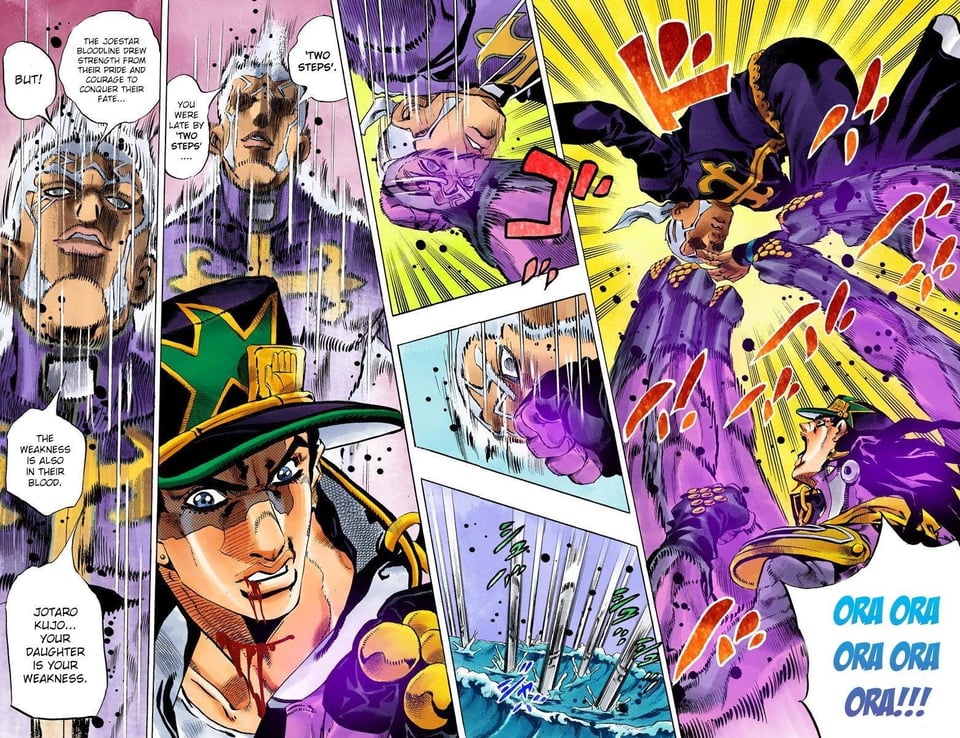
It's okay, though, because this is JoJo's. The characters are reborn in a better world, a better version of events that doesn't leave Jolyne on the receiving end of her father's trauma. Jotaro is alive and Jolyne, now Irene, is on her way to see him. We don't see Jotaro in this new world, who is named (just “Dad”) but not shown. This disappointed me the first time I read Stone Ocean. Of course, I wanted to see what came of him in this strange new world without such chains to weigh him down. But it feels right somehow to leave him to my imagination, from Holly's sweet boy to the last Crusader to a man who can just…
Rest.
This, to me, is why Jotaro is not the best JoJo but is the best character in JoJo's Bizarre Adventure. He’s flawed yet determined, oscillating between acts of violence and love. Sometimes these acts are one and the same, because he wants so much to protect the ones he loves, even when he can’t convey the depth of that love. This is why I love him, and why I think he's so beautiful.
All page screenshots are my own unless I forgot that I saved it on my phone, in which case, my apologies! Other images courtesy of JoJoWiki.com.
Add a comment: